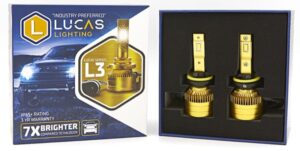Driving at night when it’s raining or snowing can be extremely difficult and often dangerous. Being able to see the road and other vehicles when your headlights aren’t adjusted perfectly is even worse. So let’s talk about proper headlight aiming and why it’s crucial to your safety and that of other vehicles on the road.
Headlights Aimed Too Low
If your headlights are aimed too low, they will illuminate the area immediately in front of your vehicle quite brightly. Not only does this prevent you from being able to see objects far down the road, but it eliminates the time you have to react. In addition, having a bright spot in front of your vehicle also causes the iris in your eyes to contract and let in less light. This further reduces your ability to see dark objects in the shadows.
Headlights Aimed Too High
If your lights are aimed too high, they will blind oncoming drivers. Many modern lighting systems produce so much light that the driver of a vehicle approaching you can’t see the road or the edges of your vehicle. You might think that the extra illumination distance afforded by having your lights a little higher makes you safer, but it puts everyone on the road at much higher risk.
Proper Alignment and Cut-Off Patterns

Most late-model vehicles have lighting systems with a sharp cutoff in the lens design. This allows for a bright spot that will illuminate far down the road. Very little light is produced above this cutoff, so your lighting system won’t blind oncoming vehicles. If you have made any modifications to your vehicle, such as a leveling kit on a truck, lowering springs on a car, a large bumper or grille guard on an SUV or a giant stereo system in the trunk, it’s crucial that you have your headlights aimed. Likewise, if you have upgraded any of the lighting in your vehicle with new bulbs or have changed forward lighting assemblies, they must be DOT-compliant and aimed correctly.
Save the Fog Lights for the Fog
Just as having your lights aimed too low puts too much light in the foreground, using your fog lights has the same effect. If you want to see as far as possible down a dark road, turn off the fog lights and dim all the dash, radio and other interior lighting as much as possible. Many factory-installed infotainment systems and aftermarket multimedia receivers have the ability to turn off the display. Turning the display off will make your eyes more sensitive to dim objects in front of your vehicle.
Don’t Overdrive Your Lights

Driving safely means you have enough time and distance to stop if you see an object in front of you. For example, if you are traveling 65 miles per hour, your vehicle covers just over 95 feet per second. However, if it takes you one second to respond to an obstacle and 120 feet to bring the vehicle to a stop, you need to see more than 200 feet to be safe. Most vehicles offer 150 to 200 feet of good illumination. As such, keep your speed in check and ensure that you are focused on objects in the distance.
Have Your Headlight Alignment Checked
If your lighting system isn’t functioning perfectly or the light lenses have faded or turned yellow, a local specialty mobile enhancement retailer can help make driving safer at night. They can also check the alignment to ensure that you can see and be seen without blinding oncoming drivers. You can find a reputable facility near you by visiting our website and using our Dealer Locator tool.


